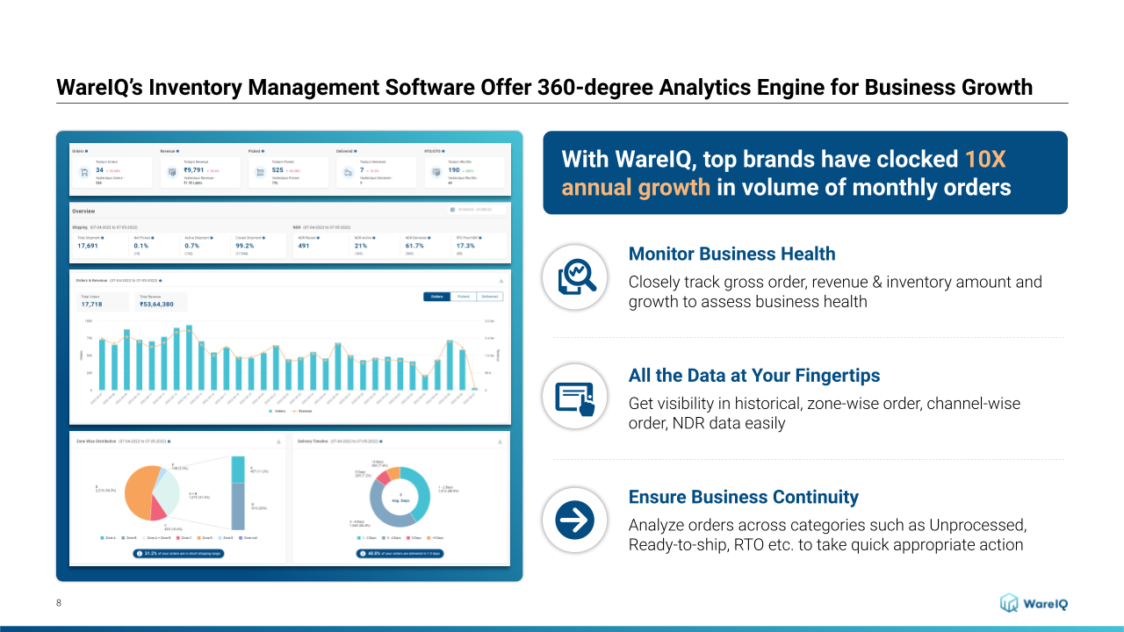What is eCommerce Customer Service? 10 Best Practices to Improve eCommerce Customer Support in 2025

For decades, eCommerce has been a growing market. Because of the Covid-19 outbreak, online buying has seen a major increase. It now plays a larger role in more people’s lives than ever before. Of course, this is wonderful news for online enterprises. However, they cannot just sit back and relax. Within the niche, competition is still fierce. Customer engagement ideas and methods are still necessary to win individuals over from your competitors.
Consumers have high expectations. It is important that you provide exceptional eCommerce customer service, customer support, and other features that enhance the user experience otherwise online buyers may look elsewhere. So, what can internet retailers do to assure excellent customer service to their customers? That’s one thing you’ll discover if you keep reading. You will also learn the importance of eCommerce customer support, 5 techniques to help you automate your eCommerce customer service, and much more.
- What is eCommerce Customer Service?
- Importance of eCommerce Customer Support
- 5 Techniques to Automate Your eCommerce Customer Service
- 10 Best Practices to Improve Your eCommerce Customer Service in 2025
- Interact With Customers on Channels They Prefer
- Make Proactive eCommerce Customer Service Your First Line of Defense
- Optimize Your Online Store for Live Chat
- Design Honest Product Catalogues
- Contact Customers on Social Media
- Empower Online Shoppers With Knowledge
- Automate Your Customer Service Process
- Personalize Every eCommerce Customer Service Interaction
- Target First Contact Resolution
- Take Customer's Opinions Into Consideration
- Conclusion
- eCommerce Customer Service: FAQs
What is eCommerce Customer Service?
eCommerce customer service is assisting online customers in a variety of ways from making smarter purchasing decisions to resolving concerns, all while offering a cohesive customer experience across many touchpoints. If your online clients have issues when making a purchase or require post-sales assistance, your customer service representatives must be able to respond quickly. eCommerce customer service issues include difficulties completing the checkout process, being unable to add items to the cart, invalid coupons, etc. These things when done right results in positive customer feedback.
WareIQ, an eCommerce fulfillment company, empowers online brands with a superior-tech platform to compete with Amazon like service levels by bringing their average delivery timelines from 5-10 days to 1-2 days.
Importance of eCommerce Customer Support
According to Microsoft’s “State of Global Customer Service” survey, 54% of consumers have already raised their expectations for the level of eCommerce customer service they receive. As a result, there is no substitute for providing excellent eCommerce customer support. The following are the most important aspects of customer care in eCommerce:
Increases Sales Velocity
83% of online buyers need help placing an order. Customers can make faster sales decisions if you can provide real-time support via live chat or by employing an eCommerce bot. This will help resolve their queries instantly so that they can continue shopping or make the payment for their order.
Improves Client Retention
The expense of acquiring a new customer is seven times that of retaining an existing customer. You can enhance client retention by providing timely eCommerce customer service and resolving customer problems in real-time. This will ensure that they have a good experience with your brand and will return to make repeat purchases and provide positive feedback to other potential customers.
Cultivates Consumer Loyalty
A well-executed eCommerce customer service plan can assist in retaining existing customers, acquiring new customers, reducing attrition, building customer loyalty, and boosting revenues in multiple ways. Customers will not need to search for other brands since they will be aware of the excellent eCommerce customer support provided by your brand.
5 Techniques to Automate Your eCommerce Customer Service
Automation in eCommerce is software solutions that handle repetitive administrative activities and reduce the need for manual data entry. And practically every step involved in running a business can be automated. However, the most beneficial automation techniques in an eCommerce customer service context are listed below:
Self-Serve Widgets
These widgets are shown on your home page and act as a portal to your help desk. It is the same as a retail assistance representative approaching you in a physical store and saying, “I’ll be over here if you need me.” They provide a vast range of functionalities to assist with eCommerce customer support.
Autoresponders
Setting up autoresponders might save your eCommerce customer support team a lot of time. If a customer sends a message inquiring about cancellations, refunds, or how to use your product, the automation tool recognizes specific phrases in the message and delivers an automatic response outlining the further steps the customer should take.
Chatbots
Chatbots are a type of conversational commerce tool that is changing the way online retailers create consumer experiences. In order to assist online clients, these automated bots examine and evaluate incoming communications before simulating human dialogue. They can be used to route users to their desired product, answer typical customer concerns or gather pertinent information before transferring them onto a live agent.
Macro Responses
These are pre-written answers to the most frequently asked eCommerce customer service inquiries and concerns. Any of the macros can be selected and customized by a professional communicating with the customer, allowing them to provide clear and concise information while still offering personalized care.
Automatic Ticket Assignment
Automatic ticket assignment is a method of automating and organizing eCommerce customer support by specifying which agents should handle specific queries and tickets will be automatically assigned to the appropriate representative so that every customer has a representative that will assist them with their queries or issues.
10 Best Practices to Improve Your eCommerce Customer Service in 2025
Want to improve your consumers’ online purchasing experience but don’t know where to begin? The following are the top 10 best practices in eCommerce customer support to consider:
Interact With Customers on Channels They Prefer
An ever-expanding eCommerce business should leave no stone unturned in providing customers with different service channels. If you confine your contact channels to phone or email, your clients may eventually flee to your competition. According to Statista, 65% of customers believe it is simple to contact a firm by phone. However, a sizable proportion (39%) find it more convenient to contact a company via social media.
Keeping up with a wide range of communication choices can be difficult for any organization. This may have an impact on the response time of your team. In fact, many online retailers may find it difficult to train multiple representatives for different platforms. As a result, the greatest solution would be to directly ask your customers. You can send them a poll in which you ask a question such as, “Which customer service channels do you prefer?” The responses will help you understand your clients and their preferences better.
Make Proactive eCommerce Customer Service Your First Line of Defense
The majority of online retailers prioritize reactive help, acting only when a consumer experiences a problem. For instance, companies only acknowledge a shipment delay when their clients request an update. You must foresee customer issues and address them before they become more serious if you want to provide wonderful eCommerce customer service. Proactive customer assistance is a strategy that should be your first line of defence against client complaints or requests. A few ways to provide proactive eCommerce customer support are listed below:
- Inform Customers of Issues Before They Become Apparent: It is crucial to be open with your clients. Declare difficulties as they arise rather than waiting for clients to approach you for assistance.
- Follow-Up With Clients: Even after a customer’s concern has been fixed, stay in touch with them frequently. Create an automatic email inquiring if consumers are experiencing the same problems repeatedly.
- Express Regret Your Errors: Let’s face it, mistakes will inevitably occur since businesses are not run by superhumans. However, you can change the course of events if you admit your error and solve it as soon as possible.
Optimize Your Online Store for Live Chat
Do you recall the last time you were browsing an online store and wondered if there were any discounts available or when an item would be available again? Prospects may be unsure of how to receive answers to their questions while browsing your eCommerce website. A live chat window that provides immediate assistance can be effective. High rates of customer satisfaction can be achieved through using live chat in your eCommerce customer support. When compared to other communication methods, live chat is preferred by 92% of clients, according to a study. A few reasons why are listed below:
- Customers can get real-time assistance from your live chat agents
- They can actually manage numerous chat sessions at once, which is not achievable through other channels like phone support
- They create chances for cross-selling and upselling
- They maintain client engagement for a connected and customized experience
Design Honest Product Catalogues
A salesperson will walk you through the features and costs of products in physical stores whereas product catalogues provide all this information for an online store. When they believe that important information is missing from product descriptions, many customers will contact your company for assistance. Some people might not think the product photos are enough, while others could remove items from their shopping basket because a discount coupon code doesn’t actually work.
About 87% of online buyers go through product descriptions for at least a minute before making a purchase from an eCommerce website. Simply by making your product catalogues better in terms of content and style, you can eliminate a sizable portion of eCommerce customer support requests. You can use the advice below:
- Provide accurate product details and pricing information
- Put several “Call to Action” buttons in strategic locations such as Share, Contact us, Add to cart, Add to wishlist, Remind me when product is back in stock, etc.
- Add pertinent HD product pictures that were taken from various angles
- Share sincere product evaluations to assist customers in making wise purchase decisions
Suggested Read: Catalog Management in eCommerce
Contact Customers on Social Media
More people than ever are using social media to interact with brands. They don’t only share photos from dinner parties or vacations; they also talk about their interactions with their favourite companies. A Microsoft study found that 50% of customers between the ages of 18 and 34 have gotten in touch with companies on social media. Social networking is a necessary component of any eCommerce customer service strategy. Leading social media sites like Facebook, Instagram, Twitter, and others have developed into effective tools for assisting current clients and luring in new ones.
Encourage your team to monitor online brand mentions made by customers. Your company will develop a solid brand reputation if you address its issues publicly. Additionally, wishing clients a happy birthday or anniversary and tagging them can greatly increase client loyalty. You can also hold contests as part of your social media strategy, rewarding winners with unique presents or money-saving vouchers.
Empower Online Shoppers With Knowledge
Customers do not always have the time or zeal to ask a human to fix their problems in the busy 21st century. When you can complete the task yourself and much more rapidly, why wait for an agent to return your call or text? After all, being able to handle a problem on your own gives you a sense of empowerment. You can set up a specific knowledge base or online help center that provides details on things like shipping costs, return policies, refund policies, anticipated delivery dates, and much more.
Numerous online vendors may have registered on your website for your online business. You need a page specifically for sellers in your online knowledge base for efficient eCommerce operations. For instance, the online marketplace for crafts and other handmade goods, Etsy, has designated sections for both vendors and buyers. You can incorporate self-help blogs, FAQs, or news about your upcoming items for a wonderful self-service experience. You can also add instructional films to your website to help clients use your items more effectively.
Automate Your Customer Service Process
Being an eCommerce customer service representative for an online retailer isn’t always easy because of the countless support difficulties, ongoing deadline pressures, and challenging clients. An automated customer support procedure can assist you in overcoming tedious, time-consuming manual operations in this specific situation. Everyone benefits from an automated workflow, including customer service managers, agents, and customers themselves.
The good news is that big data analytics and artificial intelligence don’t require you to spend a significant amount of money. You can automate your procedures and please your clients by using a straightforward support desk program. You can automate the process of creating and assigning tickets with the correct help desk technology. By doing this, it is guaranteed that all incoming support requests are instantly turned into individual tickets and assigned to the appropriate agents.
To save your agents from repeatedly entering the same responses, you can create thousands of prefabricated responses. Additionally, you can program automated emails to be sent to clients whenever an issue has been handled. With the aid of such emails, you can practice immediately collecting client feedback and giving customers the choice to review your service.
Personalize Every eCommerce Customer Service Interaction
One element unites all positive eCommerce client experiences – personalization. Personal attention can be the secret to a positive customer support experience, whether it takes the shape of product recommendations or something as basic as giving your customers offers on special occasions. A lack of personalization caused 33% of clients to end a business relationship last year, according to research by Accenture. But is it feasible to offer individualized support on a large scale? Yes, it is, as you can teach your staff to personalize every client connection and make every support session important. Here are some actions you can take to get going:
- Share product recommendations with clients on a regular basis through newsletters or while they are browsing your website. Request that your agents address customers by name when speaking on the phone or in a live chat
- To recognize and reward your recurring customers, establish a loyalty program
- Send personalized cards of gratitude along with the packaged goods
Target First Contact Resolution
First Contact Resolution (FCR) is a phrase that most eCommerce business owners must be familiar with, but only a small number of them truly understand its significance. FCR is the percentage of customer concerns that are handled by your team during the very first contact with the client. This applies to live chat and phone assistance, meaning that the customer’s request is satisfied before they hang up the phone or end the chat session. A few reasons why FCR is important are listed below:
- Saves Time for Everyone: Your agents will deal with fewer escalations and follow-up interactions when more issues are resolved during the initial engagement. All parties benefit from the time savings.
- Enhanced Effectiveness: FCR directly impacts how effective your eCommerce customer service team is. With fewer staff members, more client issues can be handled.
- Enhanced Customer Satisfaction: FCR is regarded as a major factor in determining customer satisfaction. For your expanding online business, addressing customer problems during the initial conversation is a home run.
Take Customer’s Opinions Into Consideration
Without listening to clients, nothing spectacular in any company has ever been accomplished. You can learn more about your industry, prevent bad situations from growing worse and enhance your eCommerce customer service operations by actively listening to your consumers.
To get client feedback, you can send regular surveys to customers shortly after a support encounter. To find out how pleased your consumers are with your service, conduct a customer satisfaction survey (CSAT). You can also distribute a Net Promoter Score (NPS) survey to gauge how devoted your internet audience is to your business.
Conclusion
By continually providing a superior customer experience, you can develop your eCommerce business by keeping your present clients satisfied and attracting new ones. A company’s aim, according to Sam Walton, founder of Walmart, is to provide legendary customer service rather than just the best. We hope that this article has provided you with some concepts that you may use to enhance your company’s eCommerce customer service. If you need help with enhancing your customer experience by providing them with a speedy and seamless fulfillment experience, consider partnering with WareIQ.

WareIQ is one of the leading eCommerce fulfillment providers in the country. We provide multiple eCommerce services including a nationwide network of fulfillment centers, a custom WMS that can provide real-time inventory updates and integrate with multiple eCommerce marketplaces, ultra-fast delivery through a partnership with more than 20 shipping aggregators, and much more.







